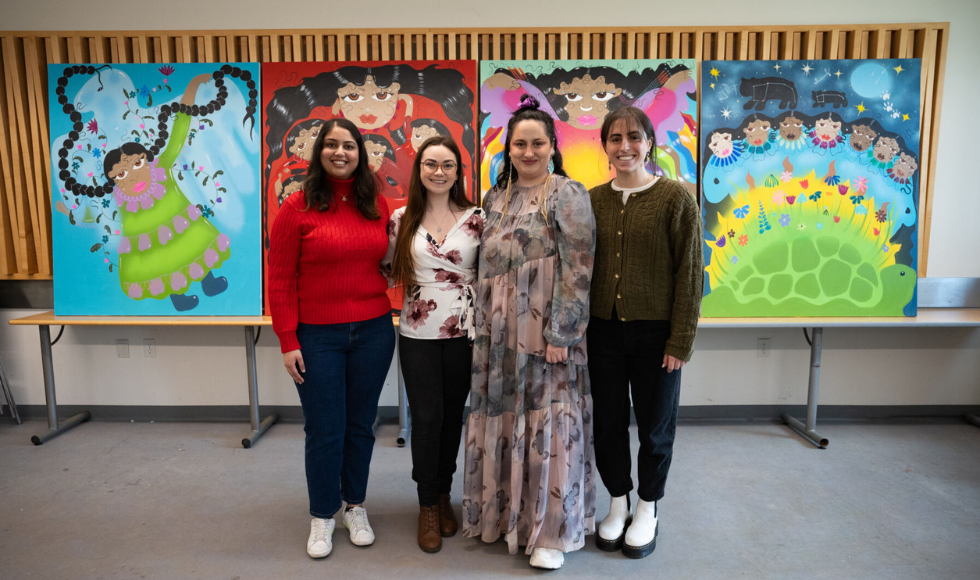For the people by the people: Science students unveil Indigenous art project

From left: Undergraduate students Alisha Sharma and Brooke Fearns with artist Natalie King and Mac grad Sage Hartmann.
For Brooke Fearns, it’s more than a mural.
The four-panel mural by Natalie King, a queer interdisciplinary Anishinaabe (Algonquin) artist, was installed this week just inside the main entrance to the Burke Science Building. King’s artwork will be the first thing hundreds of students, faculty, staff and visitors see every day while heading into the building.
Fearns, who’s a member of the Aamjiwnaang First Nation, worked on the art installation project with students Sage Hartmann and Alisha Sharma. The student-led project is part of a broader and ongoing initiative by the Dean’s Office to advance Indigenous knowledge, wisdom and culture across the Faculty of Science.
The mural’s a catalyst for overdue change, says Fearns. “It’s important to display Indigenous art on campus. It’s one way we can disrupt the historical erasure of Indigeneous people’s existence within academic institutions.”
The Human Behaviour student says art helps raise the visibility and recognize the value of Indigenous peoples and their communities.
“The mural shows that the Faculty of Science is serious about becoming a more inclusive and supportive place to learn and work for Indigenous students, faculty and staff.”
The students started working on the project in 2022 by compiling a list of Indigenous artists throughout the Greater Toronto and Hamilton Area. It was a long list that King, who’s known for bold and figurative paintings, videos and installations, topped.
“As soon as we came across Natalie’s work we immediately knew that she was the artist we wanted to collaborate with,” says Fearns. “There was never any doubt. Natalie was excited to create a meaningful piece of art.
“She’s among the many Indigenous leaders who are advocating for change within her community. She’s uplifting Indigenous people, traditional knowledge and culture while at the same time confronting the challenges our communities continue to face.”
Hartmann came back to Mac from Osgood Hall Law School for the unveiling. She had originally proposed an art installation after she was invited to review the Faculty of Science’s strategic plan and offer feedback as an Indigenous student.
“I was asked to speak truth to power,” says Hartmann, who’s from Red River Métis Nation. She says she was kindly critical and critically kind.
There was one mention of reconciliation in the strategic plan. It felt like a box was being checked.
“The Faculty of Science wanted to turn that word into action but didn’t know how or where to start.” Art would be one way to address a lack of Indigenous voices. Before leaving for law school, Hartmann asked Fearns to lead the project.
When the event invite landed in her inbox, Hartmann immediately called her mom with the news. “I was in tears.”
Sharma joined the project after Hartmann graduated. “I wanted to get involved after Sage talked about how the project was for the people by the people,” says the third-year Biomedical Discovery and Commercialization student. “I felt it was important to get involved and support this work as an ally for McMaster’s Indigenous community.”
Count Maggie Cockburn as another ally. The project coordinator in the Dean’s office supported the students from start to finish.
“Working with Brooke, Alisha and Sage has been an absolute joy,” Cockburn says.
“They’ve contributed so much enthusiasm and thoughtfulness at every step in the process. The success of this project can be attributed to their passion and efforts. It really came together around their vision.”
Working on the project gave Fearns the confidence to be a change-maker.
“I’ve been reconnecting with my own Indigenous roots so I recognize that others might have the same trepidation and self-doubt that I felt at the start of this project. But I’ve learned that it’s never too late to learn about your own or another person’s culture. And then it’s never too late to begin advocating for any social change once you’ve educated yourself. Continuous education is a powerful tool that can spark positive and impactful change.”


